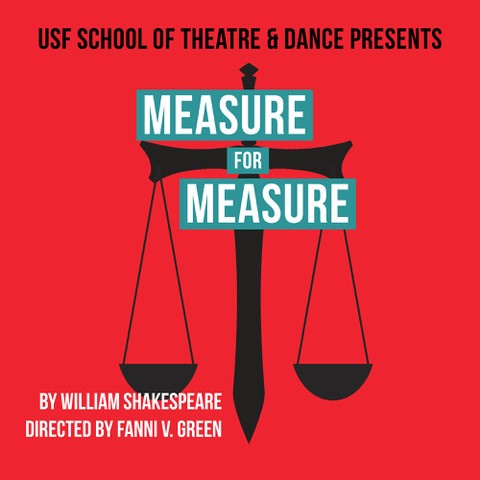By Jennifer Weiner

Fun fact: Shakespeare wrote King Lear during an outbreak of plague. “But Jennifer,” I hear you thinking, “that is hardly relevant to USF’s offering of Measure for Measure.” And I get it. You’re even mostly right. Except that there’s something about turbulent times and Shakespeare that just go hand in hand. So I was excited to sit and watch USF bring one of Shakespeare’s problem plays (and his magnum opus, in my ever-so-humble opinion) to life. What could be better than a problem play in problematic times?
Creating theatre in the middle of a global pandemic comes with a set of challenges that USF rose to meet head on. The set was beautiful and clever, painted in such a way that it was easy for the actors to tell at a glance how near and far from each other they were at any given moment. The beautifully designed period costumes were complete with coordinating contemporary face masks. The masks are a reality of today, and not without their challenges. Speaking clearly through a mask is difficult in its own right. So, too, is speaking Shakespeare’s verse. Speaking Shakespeare’s verse through a mask is an entirely new challenge, and USF’s cast makes admirable work of it.
However, for all these positive points, I must admit I struggled to fully appreciate this production. After a 10 minute intermission, the company returns to the stage and performs a choreographed Step dance. Stepping has a long history in the Black community, with its earliest origins coming out West Africa. The evolution of the dance style speaks to protest and resistance against oppression, as it became a tool of connection and outreach between BIPOC fraternities in the 20th century. There is a fine line between appropriation and appreciation. If we consider stepping as an act of protest or resistance and we understand that the people of Vienna are organizing against Angelo’s abuse of power, then maybe we’re on the side of appreciation. However, that context is never quite addressed through the action on the stage. The actors enter, dance, and disperse before the rest of the action unfolds. I feel like I am grasping at straws even considering that possibility, because the average audience does not know well enough what is about to happen in order to make that connection independently. And even I, who knows this play inside and out because it is my favorite Shakespeare play, was so taken out of the world by it that I spent the entirety of the second act searching out the cast for a single drop of melanin. Every shadow became a desperate attempt for me to identify some diversity in the characters, so that I could somehow rationalize or excuse the choice, but repeatedly came up short.






